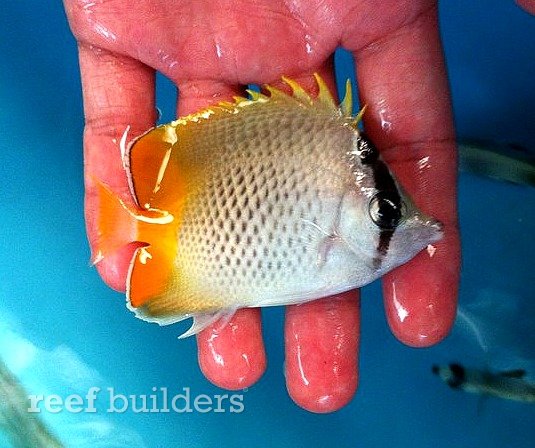When the topic of hybrid butterflyfishes gets brought up, almost certainly does the discussion revolve around the Roaps subgenus and their related hybrids. In the past year or two, we’ve seen several magnificent hybrids from this group emerging from the waters of Tarawa and the Marshall Islands. Hybrids that contain the traits of C. tinkeri, C. burgessi and even C. flavocoronatus show up now and then, many of which make their way to Japan.
Of course being hybrid butterflyfish, the traits are highly variable, with some unfortunate offspring turning out looking like the dirty burgess butterflies, or the bipolar opposite which feature almost full Flavocoronatus traits. Why are so many hybrids appearing within the Roaps subgenus? The fact that all species within that group are so similar in characteristics and lineage that hybrids frequently occur where ever their geographical range overlaps.

This brings us to the hybrid butterflyfish pictured above. The hybrid of Chaetodon xanthurus and Chaetodon guentheri is an interesting one. Both fishes are not closely related, with each of them being in their own separate complex. Often times in hybrid formation, the parents usually breed with a fish that is somewhat closely related. That’s apparently not the case for this fish. C. xanthurus is a member of the pearlscale butterflyfish complex while C. guentheri belongs to another. The resulting hybrid shows off both parent traits, bearing a crown and the orange back from C. xanthurus, while keeping the silvery body spots and orangey dorsal fin from C. guentheri.
Like the Auriga butterflyfish hybrid, this specimen hails from the waters of the Indo-Pacific. Unfortunately, this hybrid arrived in poor condition and was on the verge of death, but we did manage to snap some quick shots. Unusual butterflyfish hybrids are always fascinating, especially when they are not closely related. The Guenther’s butterflyfish has been reported to hybridize with the Wrought Iron butterflyfish in Japan, where the two species overlaps in range. We certainly hope to see more of such fishes appearing in the trade, and when it comes to hybrid combinations, your guess is as good as ours.




